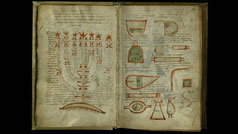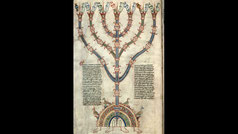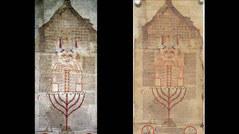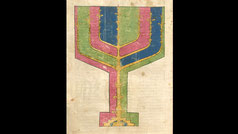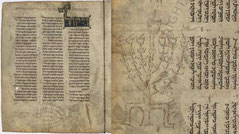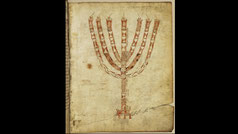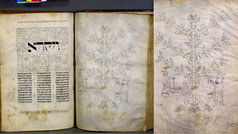ANCIENT AND NEW MENORAHS - 11th-13th Century
This website shows historic menorahs from the eleventh to the thirteenth century. Menorah illustrations from other centuries: Ancient Menorahs until the 1st century, 2nd century, 3rd century, 4th century, 5th century, 6th-10th century, 14th century, 15th century, 16th century, 17th century, 18th century, 19th century, 20th century, 21st century and coins.
Medieval Menorahs - 11th Century

11th century. Medieval Menorah with flowers. Title: "Biblia quaedam pauperum 'Legitur in Genesi .. quod dominus dixit serpenti' cum multis egregiis picturis" by Petrus de Dacia. Included work: "Compendium figurativum Bibliae 'Considerans historiae sacrae prolixitatem' cum figuris pictis. Hominis quinque aetates cum picturis. Canon supra calendarium magistri Petri Daci (superstitiose quaedam)". Germany, Bayerische Staatsbibliothek, BSB Clm 19414. Source: Link1, Link2

1000. The chandelier of the Essen Cathedral (Essener Münster, Germany), is an important bronze work of the early Middle Ages and the oldest preserved seven-armed church chandelier at all. The candlestick was made of 46 parts and shows traces of old gilding. The chandelier is a total of 2.26 meters high and has a span of 1.88 meters. Source: Link1, Link2
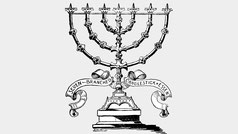
1000-1003. Essen Cathedral. There is an elaborate seven-branched candlestick at the juncture of the nave and choir, modelled on one known to have existed in the Temple at Jerusalem. It is of the conventional form, but is a rare piece of church furniture in that it dates from 1003, when it was presented by the Abbess Matilda, sister of the Emperor Otho II. Since it stands six or eight feet in height, this candlestick is a notable and conspicuous object. The Project Gutenberg E-Book. Source: Link

11th century. The Christian Topography by Kosmas Indikopleustes was both one of the most perplexing and one of the most elaborately illustrated manuscripts of the Byzantine era. Written in the 6th-century, the manuscript survives in 3 copies: Vatican Greek 699 (9th century), and two 11th-century copies: Sinai Greek 1186 in the library of Monastery of St. Katherine in Sinai (see illustration left; Christian Lamps as pigeons), and Pluteus IX.28 (see 1010 AD). Link1, Link2, Link3, Link4, Link5
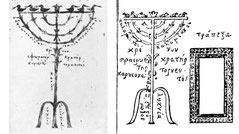
1010. Menorah representation of Kosmas Indikopleustes, phil. 9/28 (Florence: Laurentianus Plutei IX.28). A copy of a manuscript from the 6th century. The 7 lamps symbolize the 7 gifts of the Holy Spirit. The clay oil lamps are transformed into pigeons whose beaks produce flames. Kosmas was a Greek merchant and later hermit from Alexandria. His work Christian Topography (550 AD) contained some of the earliest and most famous world maps. Link1, Link2, Link3, Link4, Link5

1022. Ketubba for Evdokia bat Caleb and Namer b. Elqana dated Friday 4th Nisan 4782 (=1022 CE) in Masṭaura in Byzantium. Witnessed by Judah b. Nabon, Moses b. Leon, Selaḥya b. Joseph, and Moses b. Sabbetay. Ketubba text continues onto the verso. Language(s): Aramaic. Vellum is ruled with a sharp point on verso. Several words (mainly Greek) are vocalised with Tiberian vowel signs. The last line of recto is decorated with swirled letter tails and the drawing of a menorah mid-line. Cambridge, T-S 16.374. Link

11th century? A child's early attempts at writing the alphabet, along with childish drawings (including a menorah, a person or camel and scribbling). Alphabetical exercises, with Tiberian vocalisation, poetry. Cairo Genizah. Physical Location: Cambridge University Library. Classmark: T-S K5.19. Source: Link

11th-12th century. Leaf from a giant Bible. Origin: Italy, Central. The seven-branched candlestick (menorah), accompanied by a text derived mainly from Isidore of Seville, On the verso, 8 miniatures of musical instruments, including the psalterium, cithara, tintinnabulum, sambuca, pennula, fistula. Source: Link1, Link2, Link3

11th-12th century. Bifolium from a Children's Alphabet Primer. illuminated carpet page consisting of a menorah and six-pointed stars, followed by alphabetical exercises from a children's Hebrew textbook. The consonants alef to he are presented with different Tiberian vowels, interspersed with star designs. Blue, red, and yellow ink on parchment; 6 9/16 x 9 3/16 in. (16.7 x 23.4 cm). Taylor-Schechter Genizah Collection, Cambridge University (T-S K5.13). Source: Link1, Link1, Link2

11th century. Jewish lead seal with menorah, 5.94 g. Aramaic inscription, archangel Gabriel, Aries, goat?. Rev .: circulating Aramaic inscription, menorah, etrog, lulav and shofar. The combination of Gabriel and Aries or goat should be a reference to Daniel 8. While the seven-arm candlestick is commonly known as a Jewish symbol, etrog (a citrus fruit) and lulav (palm branch) are rather unknown as cult items of the Sukkot (Feast of Tabernacles). Gorny & Mosch Giessener Münzhandlung, Auction 147 (2006), Lot 2499. Source: Link

11th-13th century. Medieval holy land Jewish bronze seal ring; oval shaped band forming a thick bezel depicting a menorah type cross, possibly worn by a Jewish priest. intact with no restoration. Measurements: 18 mm (inner diameter); 11 gram. Source: Link
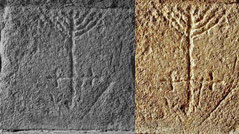
11th-12th century. Signs to be erected in Zamora (Spain), one of the greatest Iberian centers of Jewish life before the Expulsion in 1492. The experts defend the Sephardic origin of the inscription. The piece de resistance is a naïf hanukkia scratched out on one of the masonry stones at the entrance to the Church of San Pedro and San Idelfonso. Situated at ground level, this anomaly was not discovered until 2008. Source: Link1, Link2, Link3, Link4, Link5, Link6
Medieval Menorahs - 12th Century
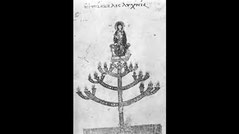
1100. Interpretation of Kosmas Indikopleustes (6th century), Smyrna. Since the 12th century there are representations of the 7-armed candelabra as a symbol of Mary. The menorah is a sign of the Holy Spirit, the Catholic "Mother of God" was suspected of being a mediator between the OT and NT. Published 1899 by Josef Strzygowski (Germany): "Der Bilderkreis des griechischen Physiologus, des Kosmas Indikopleustes und Oktateuch nach Handschriften der Bibliothek zu Smyrna." Link1, Link2
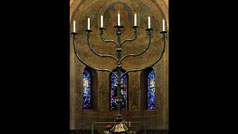
12th century. The bronze seven-armed candlestick is one of the most valuable pieces of equipment of the Braunschweig (Brunswick) Cathedral in Germany. Similar candlesticks can only be found in the Essen Cathedral, the Klosterneuburg Abbey and the Cathedral in Milan. High: 4,80m, 400kg. C. Moritz painted the candlestick in the 19th century. Source: Link1, Link2, Link3, Link4, Link5

1135. The Klosterneuburg Monastery is located northwest of Vienna, Austria. The candelabrum is the oldest surviving piece of the church. He was probably cast in bronze in Verona. In the sources the candlestick is called "sambucus" (Holunderbaum, elderberry tree) because of its tree - like form. Source: Link

1135. The Klosterburg Monastery, Collegiate Church, lower Austria, Austria. Cast work-Bronze. Same candlestick as shown above.
Source: Link1, Link2, Link3-Lilienfeld
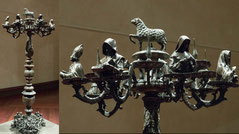
1150-1158. The "Milan or Jerusalem Candelabrum". Leg: Meuse region (Maas), around 1150. Brachest: Prague 1641, bronze. Prague, St. Vitus Cathedral, chapel of St. John the Baptist (chapel of St. Anthony). This candelabrum was part of the spoils of Vladislav from Milan year 1162. This candlestick has a new upper part, but it was definitely seven armed too. The foot is romanesque work from ca. 1150-1158.
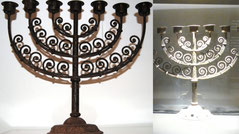
12th-15th century (?). Menorah from Girona, Catalonia (Spain), Museu d’història dels Jueus. Jewish Catalonia ranges from the 11th to the 15th century, 500 years of history. This is a piece of forged crafts for dating uncertain. The 7 grips to hold the candles are arranged all at the same height. The museum has not been able to prove its religious use: it could be both a Christian liturgical object and a decorative one of a synagogue or a Jewish home. Source: Link1, Link2

12th-14th century. A Near East peacock form menorah, Iran. Cast brass stylized peacock form menorah depicted with a spread fan tail featuring seven small oil cups. In the Torah, the peacock is described as a symbol of the faith of the people. Dimensions: Height: 4 1/4 inches (10.8 cm). Source: Link
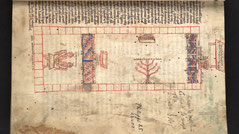
1150. Diagram, in Bede's 'About the Tabernacle'. Bede (ca. 673-735), star author of the twin monastery of Monkwearmouth-Jarrow, is most famous for his 'History of the English Church and People,' but he wrote other books, too, most of them on the bible. In the middle ages, one of his most influential works was on the description of the Tabernacle built in the desert by Moses, in Exodus 24-31. Medium: Ink and pigments on vellum. Copyright: The British Library. Source: Link1, Link2, Link3

12th century (mid). Fresco cycle of the upper vestibule of Hildesheim Cathedral (Germany), which was demolished in 1841, but copies were preserved. Zechariah stands before the seven-armed candlestick, which is between the stone with the 7 eyes and an olive tree. Behind it stand the apostles. Heimann, F. C.: Bilderhandschrift des XI. Jahrhunderts in der Dombibliothek zu Hildesheim, In: Zeitschrift für christliche Kunst 1890 (3), Heft 5. Uni Heidelberg. Source: Link1, Link2

1167-1168. Commentary on Mishnah (Neziḳin and Ḳodashim) by Maimonides Moses [author]. Drawing from the hand-written copy of the Rambam's Mishnah Torah. Rashi and Maimonides held that the branched were straight; other Jewish authorities, both classical (e.g. Philo, Josephus) and medieval (Ezra) state that the arms were round. Archaeological evidence indicates that they were not straight, but rounded. Bodleian Library MS. Pococke 295, University of Oxford. Source: Link1, Link2, Link3, Link4
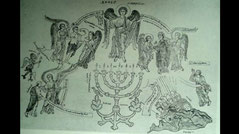
1167-1185. Presentation of the vision of Zechariah. The candlestick is flanked by two olive trees. The menorah is related to the spirit of the Lord. The Hortus Deliciarum (Latin for Garden of Delights), the first encyclopaedia verifiably written by a woman, comes from Herrad von Landsberg (1125-1195), who was abbess of the Hohenburg monastery on Odilienberg (Alsace, Germany at that time). Most of the manuscript was a compendium of 12th century knowledge. Source: Link1, Link2, Link3, Link4

12th century. Latin Gumbertus Bible (Gumbertusbibel). The death of the sons of Aaron. Library of the Gumbertusstift in Ansbach in Germany. The Gumbertus Bible is an illustrated medieval manuscript. It belongs to the impressive giant bibles, which contain the complete Bible text in a volume. It measures 67 × 46 cm and counts 394 parchment sheets with magnificent illustrations, including eleven pages. It is one of the most important works of art in Romanesque book art. Source: Link1, Link2

12th century. Compendium historiae in genealogia Christi. Title: "Histoire sainte abrégée." Images of the candlestick with seven branches (menorah); Temptation of Adam and Eve; Noah planting the vine; Biblical Genealogy... Author: Petrus Pictaviensis. Bibliothèque municipale de Lyon, Ms 863. Source: Link, Link2, Link3

12th-14th century. Menorah stone from Sobrarbe. Sobrarbe is one of the comarcas of Aragon, Spain. It is located in the northern part of the province of Huesca, part of the autonomous community of Aragon in Spain. The shape is reminiscent of the menorah stone of Andriake and Priene (today's Turkey from the 3rd-4th century). When the Aragonese Jews were expelled between 1492 and 1515, a great economic and social vacuum was left behind. Source: Link1, Link2
Medieval Menorahs - 13th Century

13th-15th century AD. A bronze ring with D-section hoop, raised discoid bezel with menorah. 6.05 grams, 24.78mm overall, 16.24mm internal diameter (approximate size British K 1/2, USA 5 1/2, Europe 10.58, Japan 10) (1"). From the collection of a Surrey gentleman; acquired 1970-1980. LiveAuctioneers, Lot 2267, 2021, Source: Link
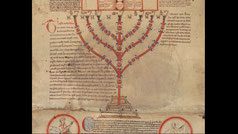
1200-1250. Compendium historiae in genealogia Christi by Petrus (Peter) of Poitiers (ca. 1130-1205). Northern France. Seven-armed menorah with almond blossoms. Cambridge (Mass.), Harvard University, Houghton Library Typ 0216 (roll) (Digital Scriptorium, app.cul.columbia.edu). Source: Link1, Link2, Link3, Link4
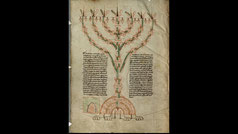
1200-1225. The MS 29 is an early 13th-century manuscript containing Peter of Poitiers (d. 1205), Genealogia historiarum (Compendium historiae in genealogia Christi) (also in CCCC MSS 83 and 437), and Petrus Comestor (d. c. 1187), Historia scholastica. The manuscript contains a number of illustrations, including a seven-branched candlestick and a seraph, with accompanying allegorical interpretations. Latin. Cambridge, Corpus Christi College. Source: Link

1201-1225. Rashi, Commentary on the Hebrew Bible with additions by other authors (Pentateuch, Jeremiah, Ezekiel, Isaiah, Minor Prophets, Five Scrolls, Psalms, Job). Language: Hebrew. Source: Polonsky Foundation Digitization Project. Rights: Photo: © Bodleian Libraries, University of Oxford, Shelfmark: Bodleian Library MS. Oppenheim 34. Source: Link1, Link2
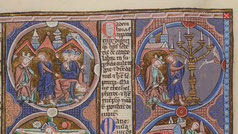
1201-1300. Biblia sacra moralisata. Biblical emblems, including the end of Job, the Psalter, the books of Solomon and the Prophets. Language: Latin. There is a mistake in this illustration, because this Menorah has only 5 arms. French Title: "Emblèmes bibliques, volume comprenant la fin de Job, le Psautier, les livres de Salomon et les Prophètes." Bibliothèque nationale de France, Département des manuscrits, Latin 11560, folio 415. Gallica. Source: Link
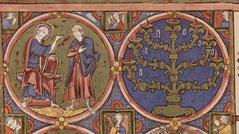
1225-1249. Bible moralisée. The book was in the 16th century in the possession of the Mercy family from Luxembourg. Language: Latin. Title: "Biblia historica-allegorica iconologica Veteris Testamenti cum textu marginali gallico. - Tabulae-Systematik: Theologia: Biblica historia." Österreichische National-Bibliothek (ÖNB), Cod. 2554 HAN MAG. Source: Link1, Link2

1226-1250. Medieval menorah mural paintings (visual works, red chalk). Provenance: Former St. Peter's Church of the Benedictine Monastery of St. Peter and Paul, Peterskirche, southern transept, south wall, Petersberg, Erfurt, Germany. Institution: Bildarchiv Foto Marburg, Germany. Source: Link1, Link2

13th century. The menorah, Petrus of Poitiers, Compendium historiae in genealogia Christi, Munich, Bavaria, Germany. Bayerische Staatsbibliothek BSB clm. 8715, fol. 6v, (Klemm 1998, Cat. 23, fig. 94). The decorative elements and their order differ from ours. Source: Link

13th century. "Petri Comestoris historia scholastica : praemittitur Patrum et Regum veteris Testamenti series chronologica ab Adamo ad Christum ; ad calcem verò subjicitur catalogus Imperatorum et summorum Pontificum à Christo ad annum 1200." Language: Latin. Material: Parchment. Gallica. Bibliothèque nationale de France. Département des manuscrits. Latin 5101. Source: Link1, Link2

13th century. Latin Manuscript. "Postille super Matheum, Johannem et Marcum. Pictavensis, Compendium historie in genealogia Christi... Postille super Prologos et Genesim." Author: Petrus Pictaviensis (112.?-1205). Bibliothèque nationale de France. Gallica, Latin 14435, vue 143 - folio NP. Source: Link, Link2

1239. Elia ben Berechiah Pentateuch, France. Pentateuch with five scrolls and Haftarot by Elia [Elijah] ben Berechiah ha-Nakdan (Scribe). Fol. 155v: Lower margin. An upright seven branched menorah with three legs, main shaft is higher than the other branches, knobs and flowers, flames turn towards the central shaft. Vatican Library (Shelf mark: VAT. EBR. 14, fol. 155). Photograph Copyright: Center for Jewish Art. Source: Link1, Link2

1250-1260. This illuminated roll contains a copy of Peter of Poitiers's (Petrus Pictaviensis) (b. c. 1120, d. 1205) Compendium historiae in genealogia Christi, the genealogy of Christ from Adam, created in England in approximately 1250-1260. It is similar in content and arrangement to the Royal MS 14 B IX. Among the additions to the basic text is a commentary on the Lord's Prayer at the end of the roll. British Library, Add MS 60628/1. Source: Link1, Link2

1250-1299. Peter of Poitiers, Compendium historiae in genealogia Christi. This illuminated roll contains a copy of Peter of Poitiers's (Petrus Pictaviensis) (b. c. 1120, d. 1205) Compendium historiae in genealogia Christi, the genealogy of Christ beginning with Adam, created in England in the second half of the thirteenth century. It is similar in content and arrangement to the slightly earlier Additional MS 60628/1. British Library, Royal MS 14 B IX. Source: Link1, Link2

1250-1299. Peter of Poitiers (ca. 1130-1205) Compendium historiae in genealogia Christi. England, MS M.628 fol. 1r. In mandorla, Christ, crossed nimbus, raising right hand in blessing. The mandorla is flanked and held by four angels each in demi-lune. All enclosed in frame resting on candelabrum. © The Morgan Library & Museum, 225 Madison Avenue, New York. Source: Link1, Link2
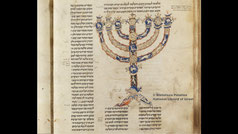
13th-14th cenutury. Commentary Torah... The Palatina Library, Parma, Italy Cod. Parm. 3204. Author: Rashi (1040-1105). © Biblioteca Palatina in Parma. This photo is only a screenshot from the website of the National Library of Israel. Please see the original source in better quality. Source: Link1, Link2
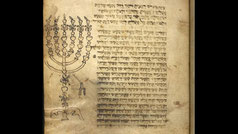
1260-1299. Medieval Pentateuch and Hafṭarot provided with vowel-points, with a sketch of the candlestick menorah (Folio 10r). Language: Hebrew. Material: Parchment. The Harley manuscripts form one of the foundation collections of the British Library, Harley MS 5683. Source: Link

13th century. Commentary on Exodus 25 by Solomon ben Isaac, known as Rashi. France. This drawing of the Menorah is placed within the column of text as a sign that it is not meant to be decorative, but is a diagram to clarify the description in the biblical passage. 12 x 19 9/16 in. (30.5 x 49.7 cm), MS. Opp. Add. Fol. 69, fol. 40a. Source: Link1, Link2, Link3
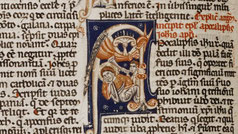
1265. Medieval Bible (without Psalms). Image description: Prologue of the Apocalypse. Monster. Argument. St. John's Vision. Revelation. Captial A farming the recumbent Saint. A trumpeter. The seven-branched candelabrum. Place of origin: Bologna, Italy. Collection: Medieval and Renaissance Manuscripts. Shelfmark: MS. Canon. Bibl. Lat. 56, folio 428v. Source: Link

1276/77. Name/Title: Toledo Bible. This photo released by the Palatina Library, based in Parma, Italy, shows a folio from a 13th century Hebrew bible written in Toledo, Spain. Artist/ Maker: Hayyim ben Israel (Scribe). Origin: Spain, Toledo Province. Location: Italy, Parma, Biblioteca Palatina, Parm. Ms. 2668. Photograph Copyright: Palatina Library, HOPD; Center for Jewish Art. Source: Link1, Link2, Link3, Link4
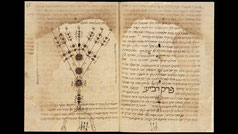
1276-1300. Title: Commentary on the Mishnah (Order Ḳodashim). Creator: Maimonides, Moses [author]. Shelfmark: MS. Bodley Or. 650 Folio/page: 47r. Source: Polonsky Foundation Digitization Project. Rights: Photo: © Bodleian Libraries, University of Oxford. Source: Link
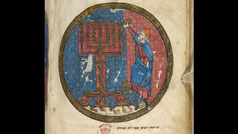
1277-1324, Miscellany of biblical and other texts ('The Northern French Miscellany' or earlier 'the British Museum Miscellany'): including the Pentateuch, Hafṭarot... - One of the most lavishly illustrated surviving Jewish manuscripts made in northern Europe. This manuscript was digitized by the British Library's Hebrew Manuscripts Digitization Project. British Library Add. MS 11639, folio 522v. Source: Link

1279. Bamberg Mahzor, Menorah of Zechariah's Vision. Origin: Bamberg, a town in Upper Franconia, Bavaria, Germany. The Jewish Theological Seminary (JTS), MS. 4843, Fol. 3v. Photograph Copyright: Center for Jewish Art. Source: Link

1280. Aaron Lighting the Menorah. Full-page miniature of Aaron pouring oil into the lighted lamps of the Tabernacle menorah. Caption: ‘This is the menorah, and Aaron putting oil to the lamps.’ Dimensions:16,2 x 12,1 cm. British Library, London, Add MS 11639. Source: Link1, Link2, Link3, Link4, Link5

1280-1299. Title: "Compendium historiae in genealogia Christi." Manuscript written and illuminated in France, probably Picardy, late 13th century. Attributed to Peter of Poitiers (ca. 1130-1205). Pierpont Morgan Library. MS M.367. Source: Link
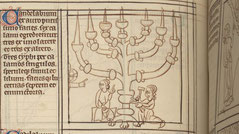
1280-1295. Illuminated Bible moralisée. The Bible moralisée functioned as a picture book of the Bible, but also offered the reader biblical interpretation. This manuscript is the only English Bible moralisée. It was copied from a French Bible moralisée in three parts (now Oxford, Bodleian Library, MS Bodley 270b; Paris, Bibliothèque nationale de France, MS lat. 11560; and London, British Library, Harley MSS 1526-1527). This picture is from the British Library, Add MS 18719. Source: Link

13th century (1250-1275). Medieval Hebrew Bible (Old Testament), Prophets and Hagiographers. Burgos. Manuscript. On the side of the page, a plant or a seven-armed Menorah was painted on a tripod for decoration. Bibliothèque nationale de France, Département des manuscrits, Hébreu 12. Source: Link1

13th-14th century. R. Elhanan's Pentateuch and Hagiographa. In the outer margin the micrographic massorah forms an eight-branched menorah with an overturned six-branched menorah as its base. Concentric circles at the center of the menorah's shaft enclose the Hebrew number for Psalm 25. Origin: Germany, Italy. Estense University Library, Alpha.J.1.22. Photograph Copyright: Center for Jewish Art. Source: Link

1287. Latin Bible from Padua, Italy. Apocalypse: Christ sending Angel to John. John, nimbed, semi-reclining, holding right hand to
face, looks toward horn blown by angel, nimbed. Above them is candelabrum. Scene within initial M decorated with foliate ornament and with foliate extenderterminating in foliate medallion
enclosing bird. Scribe: Mutinensis de Grasulfo. Pierpont Morgan Library. MS M.436. Source: Link
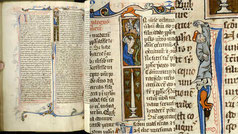
13th century (end). Latin Bible from France. Zechariah: Vision, Candelabrum, in lower compartment of decorated initial I are candlestick and seven oil lamps. In upper margin fantastic animal. In center margin is man, wearing hat, with left hand raised, standing upon fantastic animal. In lower margin is dog pursuing rabbit. Pierpont Morgan Library. MS M.969. Source: Link

1296. Menorah of the Tabernacle (Book of Leviticus) from the Rothschild Pentateuch, France and/or Germany. Leaf: 10 7/8 x 8 1/4 in. (27.5 x 21 cm). Ms. 116 (2018.43), fol. 226v. The J. Paul Getty Museum has the Rothschild Pentateuch. Created by an unknown artist. Involved: Joel ben Simeon (German second half of 15th century), Elijah ben Meshallum (active 13th century), Elijah ben Jehiel (active 13th century), Commentary by Rashi (French, 1040 - 1105). Source: Link1, Link2, Link3

13th-14th century? A Jewish manuscript smuggled into Israel from Damascus in a Mossad spy operation in the early 1990s, at Israel’s National Library in Jerusalem. Photo credit: AP Photo/Sebastian Scheiner. Source: Link

1299. Perpignan Bible, copied by Solomon ben Raphael for his personal use. Perpignan, the year 5059 of Creation. The seven-branched candelabrum flanked by a pair of ash shovels, the manna vase and its lid set with a blue stone, the branch Aaron's flower...; in a left column, the cherubim of the mercy seat. The mercy seat is set on the Ark of the Covenant, whose open doors reveal the two tablets of the Law bearing the first words of the Ten Commandments. Paris, BnF hebr. 7, fols. 12v-13. Gallica. Link1, Link2, Link3, Link4, Link5

1299-1300. Cervera Bible: Portugal's Treasure. The codex is among the oldest and most significant Sephardi Bibles that survived the destruction of most of the Jewish communities in the kingdoms of Castile and Aragon since 1391 and the expulsion of the Jews from Spain, in 1492, and from Portugal, in 1498. This beautiful and famous image shows Zechariahs vision (Zech 4:1-5) with the golden lampstand (menorah) between two olive trees. Source: please see links below.
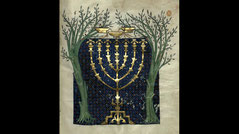
1299-1300. Cervera Bible. Source: Link

1299-1300. Cervera Bible. Menorah illumination, completed by Josef Asarfati, a Jew of French origin who settled in Castile, between 1299 and 1300 in Catalonia, Spain. The Cervera Bible is among the oldest and most significant Sephardi Bibles to survive the destruction of most of the Jewish communities in the kingdoms of Castile and Aragon beginning in 1391 and the expulsion of the Jews from Spain in 1492 and from Portugal in 1498. World Digital Libraray. Source: Link1, Link2, Link3

13th century (late). Mishneh Torah by Maimonides. Origin: Germany, France. Photograph Copyright: Center for Jewish Art. Source: Link

13th century. Bead; glass paste; decorated on obverse with a menorah; reverse, a star of David; pierced longitudinally and one hole is set with a blue bead. Made in: Venice (?), Italy. Dimensions: Length: 16 mm (max). The British Museum, number OA.1432, Source: Link

13th-14th century. Ceramic Brick. They are two fragments of two bricks with Hebrew epigraphy, recorded when the paste was still soft: one, used in a horizontal sense, contains the initial part of a biblical verse, the other, in vertical, a stylized seven-branched candelabrum or menorah and the name Sara. Place of Origin: Navacepeda de Tormes, Spain. Museo de Ávila (Spain). Source: Link1, Link2, Link3

13th-14th century. Bronze Stamp with shield and dorsal ring shape. On the front, in the field, a seven-branched candelabrum or "Menorah", a fundamental object of the Hebrew liturgy, whose foot resembles a fleur-de-lis. A peripheral girdle framed by a molding, a bilingual legend appears in Hebrew and in Latin, both readings separated by a six-pointed star located at the top; the last syllable was inserted into the field by the recorder due to lack of space. Museo Arqueológico de Sevilla. Source: Link

13th-15th century. 15" Medieval Spear trident Antique Weapon. The shape is reminiscent of the MenorahDimensions: Length: 15.1" (38.5 cm) Width max: 11.4" (29 cm). Balkan Found. Source: Link

13th century. Menorah fragment. The Cathedral of the Most Holy Savior and of Saints John the Baptist and the Evangelist in the Lateran, (Italian: Santissimo Salvatore e Santi Giovanni Battista ed Evangelista in Laterano) - also known as the Papal Archbasilica of St. John Lateran, St. John Lateran, or the Lateran Basilica - is the cathedral church of the Diocese of Rome, Italy and therefore houses the cathedra, or ecclesiastical seat, of the Bishop of Rome, the Pope. Source: Link

1300 (ca.). A seven-armed brass stand lamp, which today stands behind the altar in the choir, still refers to the Jerusalem tradition. He is 2.15 m high and on its hemispherical foot animals are depicted. The Busdorf Church is a church in Paderborn (Germany), which was built after the model of the Grab Church in Jerusalem. The Busdorf monastery was a collegiate monastery founded in Paderborn in 1036. Source: Link1, Link2

13th-14th century. Stone capital known as the Palmito, carved with a 7-branched palm frond, a Jewish symbol representing the menorah, in the Sinagoga del Agua, or Water Synagogue, Ubeda, Jaen, Andalusia, Spain. This recently discovered building is thought to be an 11th - 14th century synagogue, with yard, cellar, balcony, living room and mikveh, or Jewish ritual purification bath, fed by 7 connecting wells. Picture by Manel Cohen, Scala, Florence. Source: Link
Menorah Pictures from other Centuries:
Note: It's nice to see the menorah pictures. However, according to the Bible Jesus (Hebrew Yeshua) is the true spiritual meaning
behind the physical Menorah. He is the true and eternal spiritual light: "I am the light of the world. Whoever follows me will never walk in darkness, but will have the light
of life" (John 8:12). The menorah also symbolizes the Tree of Life, because Jesus is the way to life: "I am the way, and the truth, and the life. No one comes to the Father except through
me" (John 14:6). Jesus' Word and the Bible are the light in this world. "Your word is a lamp to my feet and a light to my path" (Ps 119:105 and John 1:1-17).
Copyright info and disclaimer: All content and all photos from ancient and new menorahs provided on this website is for informational purposes only. It is not allowed to publish photos from this website on other websites or printed literature. Please always use only the original sources of the photos. We make no representations as to the accuracy or completeness of any information on this website or found by following any link on this website. We will not be liable for any errors or omissions in this information. We will not be liable for any losses, injuries, or damages from the display or use of this information. We can not guarantee the validity and accuracy of the information, please always check the original source. The opinions expressed from other website owners and those providing comments are theirs alone, and do not reflect the opinions of us.



